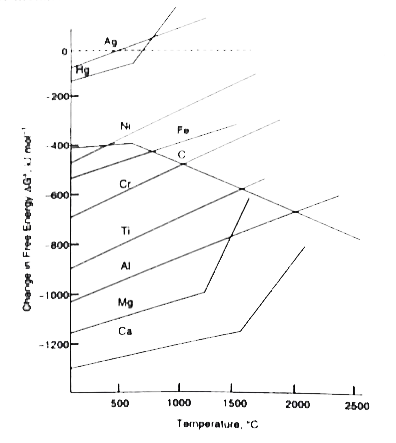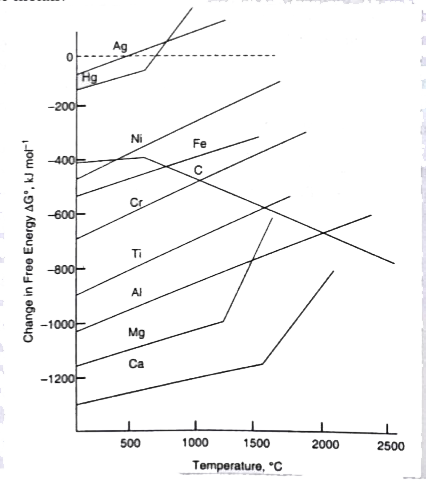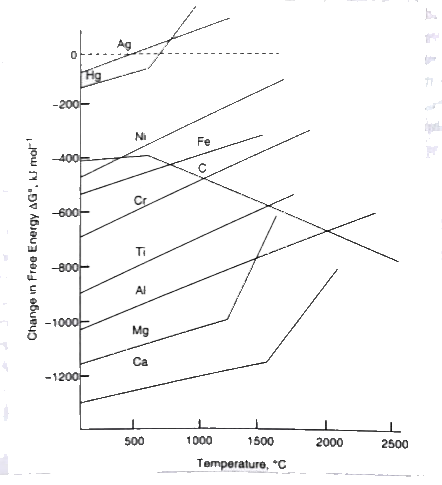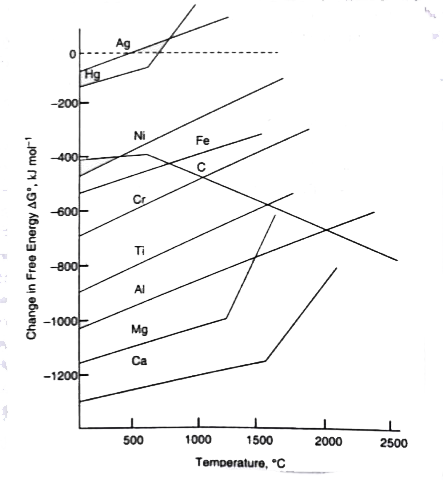Complete Solutions to Level 3 (Passive 1) of chapter METALLURGY of Class 12 book with complete answers and questions
| Class 12 | CHEMISTRY |
| Chapter | METALLURGY |
| VK JAISWAL | Level 3 (Passive 1) |
| Number Of Questions | 5 |
| Academic Year | 2023-24 |
For a sponaneous reaction, the free energy change must be negative, `Delta G=Delta H-T Delta S, Delta H` is the enthalpy change during the reaction. T is the absolute temperature, and `Delta S` is the change in entropy during the reaction. Consider a reaction such as the formation of an oxide
`M+O_(2) to MO`
Dioxygen is used up in the course of this reaction. Gases have a more random structure (less ordered) than liquid or solids. Consequently gases have a higher entropy than liquids and solids. In this reaction S (entropy or randomness) decreases, hence `Delta S` is negative. Thus, if the temperature is raised then `T Delta S` becomes more negative,Since, `TDelta S` is substracted in the equation, then `Delta G` becomes less negative. Thus, the free energy change increases with the increase in temperature.
The free energy changes that occur when one mole of common reactant (in this case dioxygen) is used may be plotted graphically aginst temperature for a number of reactions of metals to their oxides. The following plot is called an Ellingham diagram for metal oxide. Understanding of Ellingham diagram is extremely important for the efficient extraction of metals.

For the conversion of Ca(s) to Ca(s) which of the following represent the `Delta G` vs. T ?02:26View SolutionFor a sponaneous reaction, the free energy change must be negative, `Delta G=Delta H-T Delta S, Delta H` is the enthalpy change during the reaction. T is the absolute temperature, and `Delta S` is the change in entropy during the reaction. Consider a reaction such as the formation of an oxide
`M+O_(2) to MO`
Dioxygen is used up in the course of this reaction. Gases have a more random structure (less ordered) than liquid or solids. Consequently gases have a higher entropy than liquids and solids. In this reaction S (entropy or randomness) decreases, hence `Delta S` is negative. Thus, if the temperature is raised then `T Delta S` becomes more negative,Since, `TDelta S` is substracted in the equation, then `Delta G` becomes less negative. Thus, the free energy change increases with the increase in temperature.
The free energy changes that occur when one mole of common reactant (in this case dioxygen) is used may be plotted graphically aginst temperature for a number of reactions of metals to their oxides. The following plot is called an Ellingham diagram for metal oxide. Understanding of Ellingham diagram is extremely important for the efficient extraction of metals.

For the conversion of Ca(s) to Ca(s) which of the following represent the `Delta G` vs. T ?02:26View SolutionFor a sponaneous reaction, the free energy change must be negative, `Delta G=Delta H-T Delta S, Delta H` is the enthalpy change during the reaction. T is the absolute temperature, and `Delta S` is the change in entropy during the reaction. Consider a reaction such as the formation of an oxide
`M+O_(2) to MO`
Dioxygen is used up in the course of this reaction. Gases have a more random structure (less ordered) than liquid or solids. Consequently gases have a higher entropy than liquids and solids. In this reaction S (entropy or randomness) decreases, hence `Delta S` is negative. Thus, if the temperature is raised then `T Delta S` becomes more negative,Since, `TDelta S` is substracted in the equation, then `Delta G` becomes less negative. Thus, the free energy change increases with the increase in temperature.
The free energy changes that occur when one mole of common reactant (in this case dioxygen) is used may be plotted graphically aginst temperature for a number of reactions of metals to their oxides. The following plot is called an Ellingham diagram for metal oxide. Understanding of Ellingham diagram is extremely important for the efficient extraction of metals.

Free energy change of Hg and Mg for the convertion to oxides the slpe of `Delta G` vsT has been changed above the boiling points of the given metal because :View SolutionFor a sponaneous reaction, the free energy change must be negative, `Delta G=Delta H-T Delta S, Delta H` is the enthalpy change during the reaction. T is the absolute temperature, and `Delta S` is the change in entropy during the reaction. Consider a reaction such as the formation of an oxide
`M+O_(2) to MO`
Dioxygen is used up in the course of this reaction. Gases have a more random structure (less ordered) than liquid or solids. Consequently gases have a higher entropy than liquids and solids. In this reaction S (entropy or randomness) decreases, hence `Delta S` is negative. Thus, if the temperature is raised then `T Delta S` becomes more negative,Since, `TDelta S` is substracted in the equation, then `Delta G` becomes less negative. Thus, the free energy change increases with the increase in temperature.
The free energy changes that occur when one mole of common reactant (in this case dioxygen) is used may be plotted graphically aginst temperature for a number of reactions of metals to their oxides. The following plot is called an Ellingham diagram for metal oxide. Understanding of Ellingham diagram is extremely important for the efficient extraction of metals.

Which of the following elements can be prepared by heating the oxide above `400^(@)C` ?View SolutionFor a sponaneous reaction, the free energy change must be negative, `Delta G=Delta H-T Delta S, Delta H` is the enthalpy change during the reaction. T is the absolute temperature, and `Delta S` is the change in entropy during the reaction. Consider a reaction such as the formation of an oxide
`M+O_(2) to MO`
Dioxygen is used up in the course of this reaction. Gases have a more random structure (less ordered) than liquid or solids. Consequently gases have a higher entropy than liquids and solids. In this reaction S (entropy or randomness) decreases, hence `Delta S` is negative. Thus, if the temperature is raised then `T Delta S` becomes more negative,Since, `TDelta S` is substracted in the equation, then `Delta G` becomes less negative. Thus, the free energy change increases with the increase in temperature.
The free energy changes that occur when one mole of common reactant (in this case dioxygen) is used may be plotted graphically aginst temperature for a number of reactions of metals to their oxides. The following plot is called an Ellingham diagram for metal oxide. Understanding of Ellingham diagram is extremely important for the efficient extraction of metals.

As per the Ellingham diagram of oxides which of the following conclusion is true ?View Solution
Level 3 (Passive 1) questions and complete solutions for chapter METALLURGY of VK JAISWAL CHEMISTRY (HINGLISH) of Class 12
